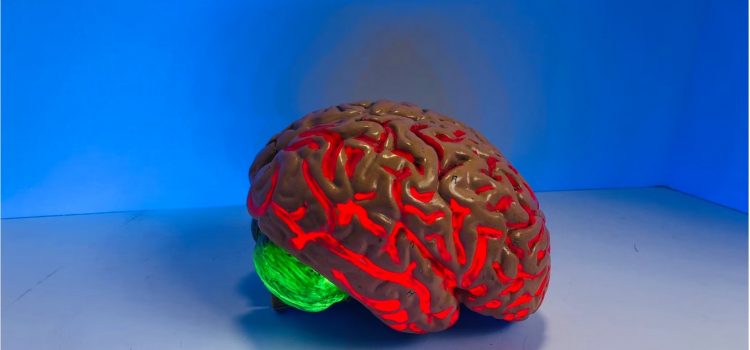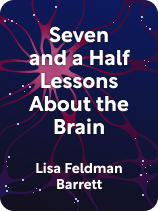

This article is an excerpt from the Shortform book guide to "Seven and a Half Lessons About the Brain" by Lisa Feldman Barrett. Shortform has the world's best summaries and analyses of books you should be reading.
Like this article? Sign up for a free trial here.
What are some amazing facts about the brain? What do these facts reveal about our minds?
In Seven and a Half Lessons About the Brain, Lisa Feldman Barrett provides facts about the brain that help us understand our control center even better. By understanding how our brain operates, you can take a more active role in deciding how to think and behave.
Let’s look at these facts about the brain that Barrett provides.
1. We Can’t Know How the Brain Works Based on Appearance Alone
The first amazing fact about the brain debunks a common misconception. Barrett argues that the way we traditionally think of the human brain is based on outdated research. There’s a popular belief that the human brain has three distinct parts, each with distinct functions: a brain core (or “lizard brain”), a limbic system, and a neocortex. The three-layer model of the brain has long been used as “proof” that the human brain is more evolved than other animal brains.
This model became popular in the mid-20th century when doctor Paul MacLean identified structural similarities and differences among the brains of different animals:
- Humans, mammals, and lizards have similar-looking brain cores. He called this the lizard brain because it was thought to be a remnant of prehistoric animals, and he argued it was the seat of instinctual behavior—something all animals seem to share.
- Humans and mammals share the next layer of the brain, one that lizards don’t have. MacLean called it the limbic system and argued it was the seat of emotions, believing that only mammals (including humans) were capable of having emotions.
- Only humans have a neocortex, the outer layer of the brain, which he argued is the seat of rational thinking. This last layer is supposed to be unique to humans and hence the seat of our uniquely human capacities.
Barrett says that researchers debunked this model in the late 20th century, yet the general public still believes it to be true.
The problem is that this model relies on what brains look like to deduce what they can do. To combat this error, Barrett explains three truths about our brain’s structure and how it functions.
First, several parts of the brain are needed, for example, to breathe, to feel angry, or to make a plan. It’s not accurate to say that there’s one specific part of the brain that deals with a specific function. (Shortform note: The understanding that several parts of the brain collaborate to perform specific tasks also debunks the common myth that the left and right hemispheres have distinct functions. While books such as The Whole-Brain Child argue that the right side of the brain deals with emotions while the left deals with rational thought, this is inaccurate.)
Second, appearance and location aren’t the only determining factors of a neuron’s function. When researchers studied neurons (nerve cells) more closely, they found that neurons from animals and humans can look very different or be found in different parts of each brain, yet have similar genetic structures. Thus, different animals can have brain cores that look similar, for instance, but that doesn’t mean that they’re responsible for primitive, instinctual functions that we believe all animals share. Likewise, just because the outer layer of our brains (the neocortex) looks different from other animals’, it doesn’t mean that the animals lack the function that our neocortex plays.
Third, most brains, including the human brain, a monkey’s brain, and a lizard’s brain, develop in the same order. According to Barrett, the difference is that they develop different parts for different lengths of time. For example, all mammals and reptiles have a cerebral cortex (part of the neocortex), but the human cerebral cortex spends more time developing so it becomes larger and more complex than that of a monkey or lizard.
2. The Brain Is a Network
Rather than a simple and static three-layer structure, Barrett says the brain is a complex and active web of neurons. Put simply, neurons are the messengers of the brain. They take in information and transmit electrical impulses to each other to communicate what is happening and how the body should react. For example, if you touch a hot stove, the neurons in your brain would receive that data and instantly tell your body to pull your hand back. Barrett goes on to explain that neurons form clusters and share information with each other. We can imagine these clusters as a group of people talking. Some of the neurons in those clusters communicate with other clusters in the vicinity (like neighbors chatting in the front yard). Some clusters are bigger and more powerful than others (such as people who have a public forum or social influence).
And some clusters communicate with other clusters across the brain, not just the ones nearby (as in email, a phone call, or on social media). In this way, the entire brain shares information and participates in shaping your experiences and behaviors.
2.5. How Brains Evolved From Cells
To better understand how allostasis (the brain’s process of energy budgeting) works, it helps to know how it has affected our brain’s evolution. Primitive organisms evolved to require more energy, so their energy-budgeting cells had to evolve to keep up with their needs.
Barrett explains that, before brains existed, primitive creatures had energy-budgeting cells that kept track of their energy needs. These cells signaled to the rest of the body when it needed to eat (or move to find food), or rest—whichever would preserve its energy best in that moment.
During the Cambrian period (starting about 541 million years ago and lasting for about 56 million years), primitive animals started needing more energy and the process of budgeting energy became more complex, so those energy budgeting cells clustered together to form a brain. Barrett explains that this evolution was due to two main factors that made energy budgeting more challenging:
1. Some primitive creatures began hunting, which meant they now had to hunt for food and escape predators. They began developing more sophisticated senses to detect danger and opportunity and to make decisions that directly impacted their energy budgets, such as whether to move (and expend energy) to try and catch prey (to gain energy) or escape danger.
2. Primitive creatures began evolving into more complex organisms with more organs and internal systems. The more complex an organism is, the more complex its energy budgeting becomes because each organ and system has specific energy requirements that need to be satisfied.
3. Allostasis Impacts Your Sensory Experience
Barrett says that your own sophisticated sensations and movements are also the result of your brain performing allostasis. Your sensory experience is actually a combination of external data from your environment and internal data from inside your body. Your brain then combines this information with memories of similar situations to motivate you to make a change that helps manage the body’s energy budget.
For example, your brain senses heat from the sun on your skin (an external sensation) and a rise in your body temperature (an internal sensation), and it tells your body to produce sweat to regulate your temperature. Your brain has to make millions of reactions like these all day, and it has to do them efficiently to stay alive. If you spend too much time in the sun without drinking water and cooling your skin with sweat, you could die. So, Barrett argues, the pressure is on for your brain to make the right call quickly.
Barrett explains that this is where the third source of information comes into play: the brain’s memories of what you’ve done before when you encountered similar information. Before it fully processes the external and internal information it receives, it searches its memory for previous situations where the environment and your body felt similarly. It recalls what it did in that situation and triggers an action for today. This allows your brain to be one step ahead and make decisions quickly and efficiently.
All of this happens before the brain has time to contrast the real sensory data with the experience it created for you. Barrett says this is why you feel less thirsty immediately after drinking water, even though that water won’t reach your bloodstream until 20 minutes later. Your brain knows you’ll be satisfied in a little while, so it creates the experience of quenched thirst.
4. The Brain Needs Lots of Help to Develop Successfully
Barrett explains that after birth, a baby’s brain develops according to its genetic coding and the physical and social environment. Genes help develop the basic infrastructure of the brain while environmental input triggers brain plasticity to develop certain neural connections more or less strongly.
Barrett identifies two specific processes that take place in the newborn’s brain as genes and the environment interact:
- Tuning: Important connections between neurons get stronger the more they’re used or the more essential they are for energy budgeting. For example, the baby learns to suck on a bottle or her mother’s breast very quickly because it’s a crucial energy budgeting task that she repeats several times a day. (Shortform note: Babies are born with roughly 100 neurons, and during their first year of life, babies’ brains generate more than a million new neural connections each second.)
- Pruning: Unnecessary connections are dismantled to make room for more important ones. For example, babies are born with connections to help them identify a wider variety of flavors than adults, but over time most of those connections are lost to prioritize the ones that help them distinguish flavors they’re more commonly exposed to. (Shortform note: This process of synaptic pruning happens when a child is about six years old.)
According to Barrett, the environment—especially the quality of the baby’s caregivers—is essential during this process. While the baby’s brain is developing, caregivers perform energy budgeting tasks for them, such as feeding them, helping them sleep, and comforting them when they’re distressed. This allows the brain to spend more energy tuning and pruning. Conversely, children who don’t receive adequate physical and social support from their environment have difficulties developing their brains. This happens in situations where there is poverty or neglect, for example.
5. Brains Develop Into Unique Minds
Although our brains (physical organs) share a basic architecture, each one gets tuned and pruned according to its environment, producing widely different minds (individual patterns of thought and action). This is similar to the way two college students might buy the same laptop with the same basic capabilities (brain), but they each load certain programs onto their laptops (and delete others) based on what they are studying (since their needs and culture will be different). One student might have more money and more expensive software and accessories, while the other might use the free or cheap ones (since their conditions and environment will vary as well). As a result, the two computers will appear very different once you boot them up, just like our minds.
Barrett claims that this capacity for brain variation is the result of our brain’s plasticity and complexity, as neurons and neural clusters change to meet environmental needs. This flexibility makes humans adaptable to different environments, aiding in our evolution and survival as a species. As individuals, it also allows us to alter our minds by exposing ourselves to new stimuli and learning intentionally.
6. Brains Collaborate in Four Ways
Barrett explains that our brains are constantly collaborating with each other in four key ways:
1. Our interactions with other people encourage our neurons’ tuning process to strengthen certain neural connections over others. This process is particularly intense when we’re newborns, but it continues throughout life. For example, when you interact often with a person who speaks a different language, you might learn to speak some words in their language to communicate more easily with them.
2. Our internal bodily functions have a regulating effect on the people around us, Barrett says. Brains coordinate with brains around them, matching breathing and heartbeat patterns, especially when we’re in intense interactions (whether they’re positive or negative). This can have a calming effect, for example, or help you collaborate with others more effectively.
3. Our conscious actions impact others’ energy budgets and well-being. For example, Barrett claims that saying something comforting to a person in distress can help them relax and require less energy to bring themselves back to a neutral state. On the other hand, acting in a threatening way can trigger their danger response and increase their energy load.
4. Our brains collaborate to create a shared social reality, which includes all of the sociocultural elements that structure our life and don’t rely on physical reality. For example, we agree on national borders, the value of products and currencies, the authority of certain figures, and the power of laws.
Humans are able to create social reality because we have the following abilities:
- Creativity: the ability to generate new ideas
- Communication: the ability to share those new ideas with others
- Cooperation: the ability to work together to make ideas part of our reality
- Copying: the ability to follow other people’s example
- Compression: the ability to absorb and summarize huge amounts of information and extract meaning from them based on their function rather than their shape.

———End of Preview———
Like what you just read? Read the rest of the world's best book summary and analysis of Lisa Feldman Barrett's "Seven and a Half Lessons About the Brain" at Shortform.
Here's what you'll find in our full Seven and a Half Lessons About the Brain summary:
- How the human brain develops and operates
- Why the brain isn't organized in the way you thought it was
- How brains collaborate with one another






